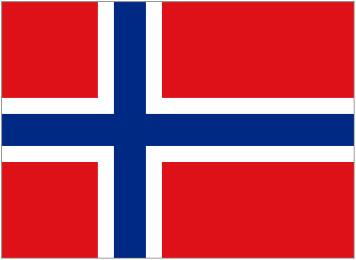At noon, Amundsen announced to his men a change in plans. Amundsen would lead one party to the Pole while Prestrud--with Johansen--would lead a second party to explore King Edward VII Land. Amundsen's decision was not a revengeful one as he felt that if the Pole party were not successful, at least there might still be a "first" gained for Norway. Amundsen then spoke to each man individually (ignoring Johansen), asking for his pledge of loyalty...all gave it. And so, on October 20, 1911, Amundsen, Bjaaland, Wisting, Hassel and Hanssen departed on their historic journey to the Pole. Four sledges were used, each pulled with 13 dogs. They made good progress, other than a little trouble with crevasses, and arrived at 80°S depot on the 24th. They uncovered the provisions and gave the dogs a feast of seal meat and blubber. The next day the party left with all five men on skis. On the way south, they spotted a cairn still standing as they had built it the prior April. Thus proving reliability, another 150 similar cairns were built on the journey south, each left with a written record inside stating the distance and bearing to the next cairn. Each day, as they built their cairn, lunch was eaten..."nothing very luxurious", wrote Amundsen, "three or four dry oatmeal biscuits, that was all. If one wanted a drink, one could mix snow with the biscuit". They arrived at 82°S depot on November 4. Two days later they left...they were accomplishing 20 miles each day, in only five hours, after which they would build their cairn, in an hour and a half, and then rest for the remainder of the day. On November 11 the peaks of mountains were seen in the distance, which Amundsen later named Queen Maud's Range, after the Queen of Norway. At the foot of the range they camped and discussed strategy for the final push to the Pole, some 340 miles distant. The final plan was to take supplies and provisions for 30 days, along with the remaining 42 dogs, and make the climb. After reaching the top, 24 of the dogs would be shot, since they would no longer be needed, using the remaining 18 in the final dash for the Pole. Once reached, six more would be slaughtered to provide food for the remaining twelve on the trip back to Framheim. On November 17 they started the climb up the Axel Heiberg Glacier. The weather was warm and the climb even better as they covered 11.5 miles before making camp at 2000 feet. Four days later, on November 21, they found themselves at the summit. They'd managed to carry a ton of supplies to an altitude of 10,000 feet. Twenty-four dogs were shot and the party stayed at "The Butcher's Shop", as it was now called, for four more days before heading off into a raging blizzard. They had already waited two days longer than planned so they had no choice but to push on. For the next ten days they struggled, five men and 18 dogs, against driving snow in 35 mph winds and thick fog. At last they reached the plateau, only to be confronted by "The Devil's Ballroom", a glacier with a thin crust of snow covering a number of dangerous, deep crevasses. This proved to be the last major obstacle.Roald Amundsen has the distinction of being the first man to both poles. Although not the first to the North Pole, he did cross it with Lincoln Ellsworth on the airship Norge. This flight was from Spitsbergen to Alaska via the North Pole. Thus another first for the man: The 1st trans-Arctic Flight.
On December 8, with the sun shining brightly, they passed Shackleton's farthest south, 88°23'S. They were only 95 miles from the South Pole. The dogs were hungry and exhausted, the men had many sores and frostbitten faces, yet still the party pushed on. The closer they came to the Pole, the more Amundsen worried that Scott had already beaten them. The temptation to race on, at full speed, was shared by everyone. At 3:00 pm, on Friday, December 14, 1911, there was a simultaneous cry of "Halt!" as the sledge meters registered their arrival at the South Pole. They had achieved their goal. Symbolic of their struggle in unity, each of the men, with their weathered and frostbitten hands, grasped the Norwegian flag and planted it firmly at the geographical South Pole. Amundsen named the plain King Haakon VII's Plateau. There were festivities in the tent that evening with each man sharing a little seal meat. At midnight observations were taken that put them at 89° 56'S. Arrangements were now made to encircle the camp with a radius of approximately twelve and a half miles.
At noon, on December 17, the observations had been completed and it was certain the men had done all that could be done. In order to come a few inches closer to the actual Pole, Hanssen and Bjaaland went out four geographical miles and promptly returned. Bjaaland surprised Amundsen when he pulled out a cigar-case full of cigars at dinner. A cigar at the Pole! Following the festival dinner, preparations for departure began. A tent was erected, naming it Poleheim, with Amundsen leaving a message inside for Scott, along with a letter for King Haakon. Thirty-nine days later the party returned to Framheim, as planned, with all five men and 11 dogs "hale and hearty". The month-long voyage back to Tasmania was a frustrating time for Amundsen, who was now quite anxious to be the first to announce the news of their achievement. On March 7, 1912, Amundsen finally cabled his brother Leon with the historic news.
Source
His achievement was celebrated at Amundsen-Scott Base (90 degrees South)


1 comment:
wow that is something else! have an awesome day my friend!:)
Post a Comment